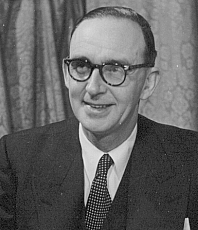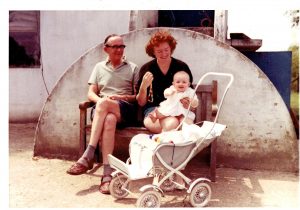
Text and photos kindly provided by Penny Allsop granddaughter of Tommy Law.
Thomas Alick Law was born on 4 November 1905 in Tetbury, Gloucestershire.
Thomas Law is best known as the man who chanced upon an invention that could produce copies of documents as good as the original. It was his actions that lead to the photocopier taking the world by storm.
Thomas Law was educated as an electrical and radio communications engineer. He worked for the Rank Organisation Ltd for thirty years and was Managing Director of Rank Xerox from 1956-67. He began his association with the Rank Organisation in 1929 when he joined British Acoustic Films, a subsidiary of Gaumont British Picture Corporation, as Chief Engineer. He became Managing Director of Rank Precision Industries Ltd (then known as British Optical and Precision Engineers Ltd) in 1951 and was appointed Managing Director of Rank Xerox in 1956.
In 1956 Rank was looking for a product to sit alongside a small business it had making camera lenses. The head of the business, Thomas Law, found his answer in a scientific magazine he picked up by chance. He read about an invention that could produce copies of documents as good as the original (Daily Telegraph, 7 June 1997). Mr Law tracked down the backers – Haloid*, the company that became Xerox – and Rank ended up by putting up £600,000 for a 50% stake in Rank Xerox which was forced to exploit the opportunities for photocopiers outside America.
As photocopying took the world by storm, so did Rank’s profits. According to Graham Dowson, Rank’s Managing Director in 1956, it was “a stroke of luck that turned out to be a touch of genius … If Tom Law had not seen that magazine, we would not have known about xerography – or at least not before it was too late.” (Daily Telegraph, 13 January 1995)
Law resigned from the boards of Rank Precision Industries and its subsidiaries in June 1963 in order to concentrate on his work in Rank Xerox Ltd. He became a member of the parent board of the Rank Organisation in May 1964.
Thomas Law died of pneumococcal meningitis on Saturday 15 April 1967 which he contracted from a swimming pool in Africa.
In April 1967 the Rank Xerox Gazette included a message from John Davis, Chairman and Chief Executive of The Rank Organisation, stating “Tom Law was above everything a kindly warm hearted man and in more than a score of countries his loss is felt as keenly as it is here in the United Kingdom. As Managing Director of Rank Xerox he had quite naturally the capacity to inspire respect and to win affection, to give clear leadership but never to lose his charming and quietly unassuming manner. Whether talking on equal terms with technicians who were working to apply the brilliant new scientific process of xerography to the practical needs of the world’s business community, or considering the personal problem of a member of his team, Tom Law played a full part. The scope of Rank Xerox operations today is the finest memorial to his achievements… I hope that Tom’s example will provide an inspiration for the many young people in the Company he has left behind him. His achievements are there for all to see, but let us not forget that above all he cared about people.”
Personal Life
He married Isabelle Doris Hancock in 1932. They had one daughter named Anne Elizabeth Law. Anne married Michael Allsop and they had three children, Carole Allsop, Penelope Allsop and Robin Allsop.
*Note on Haloid: In the 1940s, researchers at Battelle Memorial Institute (a charitable trust organized as a nonprofit research corporation in Columbus, Ohio) developed Chester Carlson‘s concept of dry copying. Work led to the first commercial xerographic equipment, and to the formation of Xerox corporation. In 1947 Haloid (a photography-paper business named The Haloid Company, established in 1906 in Rochester, New York) entered into an agreement with Battelle to produce a machine based on this new process called xerography.
Background on Haloid
Xerox can trace its roots to 1906, when a photography-paper business named The Haloid Company was established in Rochester, New York. Its neighbour, Eastman Kodak Company, ignored the company, and Haloid managed to build a business on the fringe of the photography market. In 1912 control of the company was sold for $50,000 to Rochester businessman Gilbert E. Mosher, who became president but left the day-to-day running of the company to its founders.
Mosher kept Haloid profitable and opened sales offices in Chicago, Boston, and New York City. To broaden the company’s market share, Haloid’s board decided to develop a better paper. It took several years, but when Haloid Record finally came out in 1933 it was so successful that it saved the company from the worst of the Great Depression. By 1934 Haloid’s sales were approaching $1 million. In 1935 Joseph R. Wilson, the son of one of the founders, decided that Haloid should buy the Rectigraph Company, a photocopying machine manufacturer that used Haloid’s paper. To help pay for the acquisition, Haloid went public in 1936, and selling Rectigraphs became an important part of Haloid’s business.
In 1936 Haloid’s 120 employees went on strike for benefits and higher wages. When Mosher proved intransigent, Wilson stepped in and offered concessions. Tension and resentment between labor and management persisted until World War II. During the war the Armed Forces needed high-quality photographic paper for reconnaissance, and business boomed. When the war ended Haloid faced stiff competition from new paper manufacturers.
Amidst this, Haloid needed to come up with new products, particularly following a showdown between Mosher, who wanted to sell Haloid, and Wilson, who did not. Wilson won, and in 1947 Haloid entered into an agreement with Battelle Memorial Institute, a nonprofit research organization in Columbus, Ohio, to produce a machine based on a new process called xerography.
Xerography, a word derived from the Greek words for “dry” and “writing,” was the invention of Chester Carlson. Carlson was born in Seattle, Washington, in 1906 and became a patent lawyer employed by a New York electronics firm. Frustrated by the difficulty and expense of copying documents, Carlson in 1938 invented a method of transferring images from one piece of paper to another using static electricity. In 1944 Battelle signed a royalty-sharing agreement with Carlson and began to develop commercial applications for xerography.
In 1949, two years after Haloid signed its agreement with Battelle, Haloid introduced the XeroX Copier, initially spelled with a capital X at the end. The machine, which required much of the processing to be done manually, was difficult and messy to use and made errors frequently. Many in the financial community thought that Haloid’s large investment in xerography was a big mistake, but Battelle engineers discovered that the XeroX made excellent masters for offset printing, an unforeseen quality that sold many machines. Haloid invested earnings from these sales in research on a second-generation xerographic copier.
In 1950 Battelle made Haloid the sole licensing agency for all patents based on xerography, but Battelle owned the basic patents until 1955. Haloid licensed the patents liberally to spread the usage of xerography to such corporations as RCA, IBM, and General Electric. In 1950 Haloid sold its first commercial contract for a xerographic copier to the State of Michigan. Meanwhile, Haloid’s other products were again highly profitable, with paper sales increasing and several successful new office photocopying machines selling well.
In 1953 Carlson received the Edward Longstreth Medal of Merit for the invention of xerography from the Franklin Institute. In 1955 Haloid revamped its 18 regional offices into showrooms for its Xerox machines instead of photo-paper warehouses, hired 200 sales and service people, began building the first Xerox factory in Webster, New York, and introduced three new types of photography paper. Haloid also introduced the Copyflo, Haloid’s semiautomatic copying machine. In 1956 Haloid President Joe Wilson, Joseph R. Wilson’s son, formed an overseas affiliate called Rank Xerox with the Rank Organisation Plc, a British film company seeking to diversify. This arrangement paved the way for Xerox factories in Great Britain and a sales and distribution system that brought Xerox machines to the European market.
In 1958 Haloid changed its name to Haloid Xerox Inc., reflecting its belief that the company’s future lay with xerography, although photography products were still more profitable. That balance quickly changed with the success of the Xerox 914 copier. Introduced in 1960, it was the first automatic Xerox copier, and the first marketable plain-paper copier. The company could not afford a blanket advertising campaign, so it placed ads in magazines and on television programs where it hoped business owners would see them. The company also offered the machines for monthly lease to make xerography affordable for smaller businesses.
Demand for the 650-pound 914 model exceeded Haloid Xerox’s most optimistic projections, despite its large size. Fortune later called the copier “the most successful product ever marketed in America.” Sales and rental of xerographic products doubled in 1961 and kept growing. In 1961 the company was listed on the New York Stock Exchange, changed its name to Xerox Corporation, and photography operations were placed under the newly created Haloid photo division. In 1962 Rank Xerox formed Fuji Xerox Co., Ltd. in Japan with Fuji Photo Film Co., Ltd. Also during the 1960s Rank Xerox opened subsidiaries in Australia, Mexico, and continental Europe. The company had sunk $12.5 million into developing the 914 copier, more than Haloid’s total earnings from 1950 to 1959, and the 914 had led the company to more than $1 billion in sales by 1968. In 1963 Xerox introduced a desktop version of the 914, Although this machine sold well, it was not very profitable, and Xerox depended on its larger machines thereafter.
With its suddenly large profits, Xerox began a string of acquisitions, purchasing University Microfilms in 1962 and Electro-Optical Systems in 1963. The market for copiers continued to expand at such a rate that they remained Xerox’s chief source of revenue. The 1960s were a tremendously successful time for Xerox, which became one of the 100 largest corporations in the United States and, in 1969, moved its headquarters to Stamford, Connecticut.
In the late 1960s Xerox began to focus its efforts on the concept of an electronic office that would not use paper. With this end in mind the corporation bought a computer company, Scientific Data Systems, in 1969, for nearly $1 billion in stock, only to have it fail and close down in 1975. Xerox also formed Xerox Computer Services in 1970, bought several small computer firms in the next few years, and opened the Xerox Palo Alto Research Center (PARC) in California.

